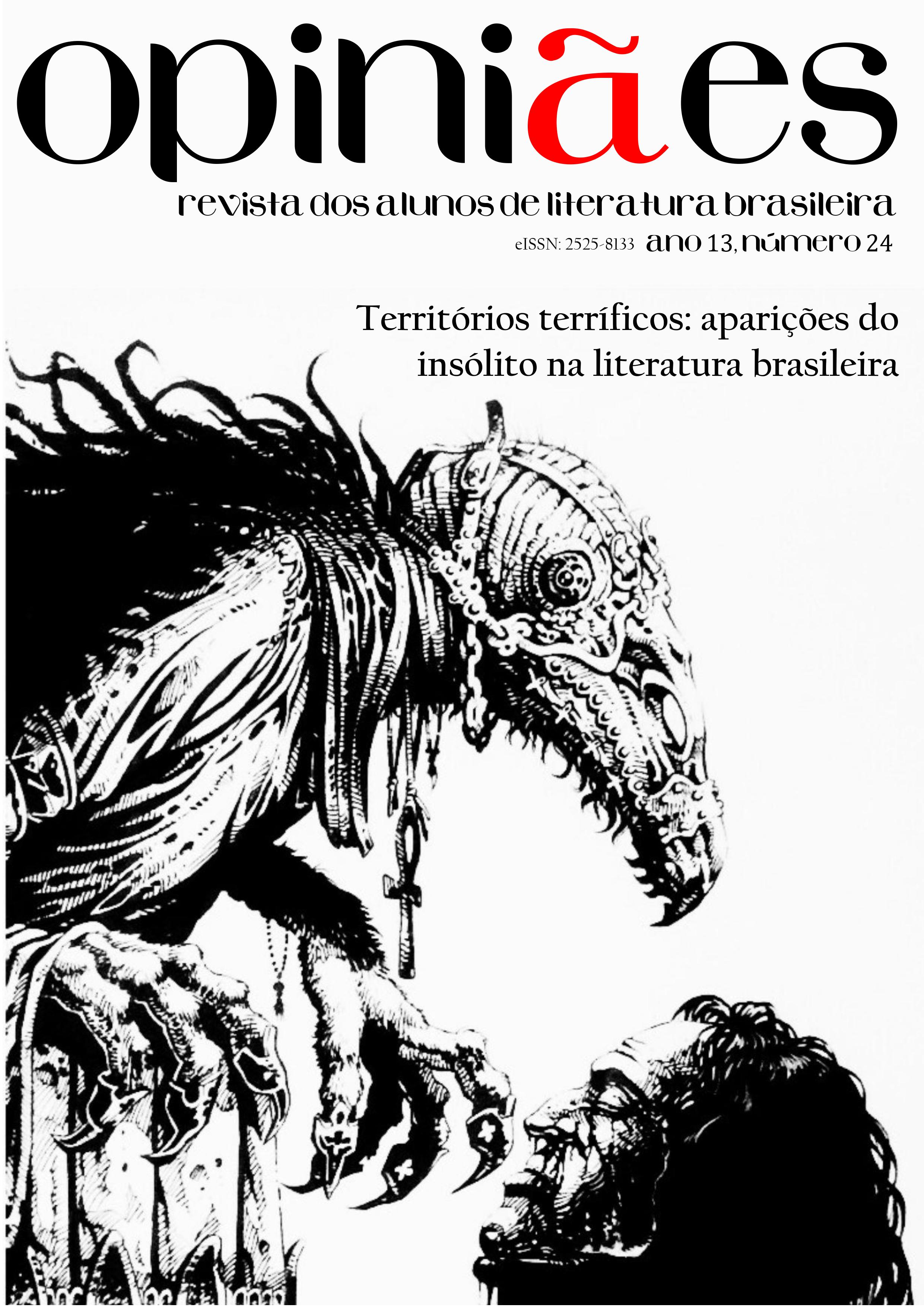O Judeu Errante em Imortalidade (1925), de Coelho Neto
DOI:
https://doi.org/10.11606/issn.2525-8133.opiniaes.2024.222282Palavras-chave:
Judeu errante, Imortalidade, Coelho NetoResumo
No Brasil, para além de alguns esforços individuais, parece não ter havido muito interesse pelo estudo da figura do Judeu Errante. O presente artigo propõe-se mostrar como os temas de Fausto e do Judeu Errante, que já haviam aparecido em The Monk (2002), de Matthew Gregory Lewis, em episódios separados, relativos a personagens diferentes, reaparecem no romance Imortalidade (1925), de Coelho Neto, em uma combinação engenhosa, que, no entanto, contém os motivos fundamentais da narrativa do Judeu Errante: longevidade sobrenatural, errância e ofensa contra a divindade.
Downloads
Referências
ANDERSON, George Kumler. Popular Survivals of the Wandering Jew in England. The Journal of English and Germanic Philology, v. 46, n. 4, pp. 367-382, 1947.
ANDERSON, George Kumler. The Legend of the Wandering Jew. Providence: Brown University Press, 1965.
ARARIPE JÚNIOR, Tristão de Alencar. Movimento de 1893. O crepúsculo dos povos. Rio de Janeiro: Tipografia da Empresa Democrática Editora, 1896.
BALDICK, Chris. In Frankenstein’s Shadow: Myth, Monstrosity, and Nineteenth-Century Writing. Oxford: Clarendon Press, 1996.
BARING-GOULD, Sabine. Curious Myths of the Middle Ages. Boston: Roberts Brothers, 1867.
COHEN, Richard I. Images et Contexte du Juif Errant Depuis le Mythe Médiéval Jusqu’à la Métaphore Moderne. In: SIGAL-KLAGSBALD, Laurence (ed.). Le Juif Errant: un témoin du temps. Paris: Musée d’art et d’histoire du Judaïsme, 2001. pp. 13-31.
COHEN, Richard I. The ‘‘Wandering Jew’’ from Medieval Legend to Modern Metaphor. In: KARP, Jonathan; KIRSHENBLATT-GIMBLET, Barbara (ed.). The Art of Being Jewish in Modern Times. Filadélfia: University of Pennsylvania Press, 2008. pp. 147-175.
FALCHI, Simonetta. The Wandering Jew and his other self: Faust. In: COCCO, Simona Maria; DELL’UTRI, Massimo; FALCHI, Simonetta (Orgs.). L’altro. I molteplici volti di un’ineludibile presenza. Roma: Aracne editrice, 2012. pp. 47-59.
FELSENSTEIN, Frank. Anti-semitic Stereotypes. A Paradigm of Otherness in English Popular Culture, 1660-1830. Baltimore; Londres: The Johns Hopkins Unversity Press, 1995.
GINWAY, Mary Elizabeth. Introduction. In: COELHO NETO. Esfinge: um romance neogótico do Brasil. Nova York: Modern Language Association of America, 2023. Disponível em: https://www.google.com.br/books/edition/Esfinge/Q4nSEAAAQBAJ?hl=pt-BR&gbpv=0 Acesso em: 6 dez. 2023.
KLIK, Marcin. The Crisis of the Notion of Literary Myth in French Literary Studies. In: LIPSCOMB, Antonella; LOSADA, José Manuel (Org.). Myths in Crisis. The Crisis of Myth. Cambridge: Cambridge Scholars Publishing, 2015. pp. 91-102.
LAMPERT-WEISSIG, Lisa. The Time of the Wandering Jew in the Chronica Majora and the De Brailes Hours. Philological Quarterly 96.2, pp. 171-202, 2017.
LAMPERT-WEISSIG, Lisa. The Transnational Wandering Jew and the Medieval English Nation. Literature Compass, v. 13, n. 12, pp. 771-783, dez. 2016.
LEWIS, Mathew Gregory. The Monk. Nova York: The Modern Library, 2002.
LOPES, Hélio. Ahasvero, tema literário. In: LOPES, Hélio; BOSI, Alfredo (org.). Letras de Minas e outros Ensaios. São Paulo: Editora da Universidade de São Paulo, 1997. pp. 309-314.
COELHO NETO. Imortalidade. Porto: Livraria Chardron, de Lello & Irmão, L.da editores, 1925.
PEREIRA, K. M. de A. O andarilho e o romântico: o mito do Judeu Errante em Castro Alves, Arquivo Maaravi: Revista Digital de Estudos Judaicos da UFMG, v. 8, n. 15, pp. 79-94, 2014. Disponível em: https://periodicos.ufmg.br/index.php/maaravi/article/view/14234. DOI: https://doi.org/10.17851/1982-3053.8.15.79-94. Aecsso em: 01 jul. 2024.
RAILO, Eino. The Haunted Castle: A Study of the Elements of English Romanticism. Nova York: Taylor and Francis, 2019. Disponível em: https://www.perlego.com/book/1503605/the-haunted-castle-a-study-of-the-elements-of-english-romanticism-pdf. Acesso em: 6 dez. 2023.
ROSENBERG, Edgar. From Shylock to Svengali. Jewish Stereotypes in English Fiction. Stanford: Stanford University Press, 1960.
ROUART, Marie-France. The Myth of the Wandering Jew. In: BRUNEL, Pierre (Org.). Companion to Literary Myths, Heroes and Archetypes. Nova York: Routledge, 1996. pp. 826-834.
SCARBOROUGH, Dorothy. The Supernatural in Modern English Fiction. Nova York: The Knickerbocker Press, 1917.
VASCONCELOS, Carolina Michaelis de. O Judeu Errante em Portugal. Revista Lusitana, pp. 34-45, 1887/1889.
VASCONCELOS, Carolina Michaelis de. O Judeu Errante em Portugal. Revista Lusitana, n. 2, pp. 74-76, 1893/1895.
Downloads
Publicado
Edição
Seção
Licença
Copyright (c) 2024 Ana Resende

Este trabalho está licenciado sob uma licença Creative Commons Attribution 4.0 International License.
A revista Opiniães não exerce cobrança pelas contribuições recebidas, garantindo o compartilhamento universal de suas publicações. Os autores mantêm os direitos autorais sobre os textos originais e inéditos que disponibilizarem e concedem à revista o direito de primeira publicação, com o trabalho simultaneamente licenciado sob a Licença Creative Commons Attribution que permite o compartilhamento do trabalho com reconhecimento da autoria e publicação inicial nesta revista.
Dados de financiamento
-
Coordenação de Aperfeiçoamento de Pessoal de Nível Superior
Números do Financiamento 001



